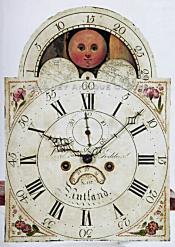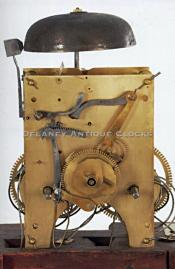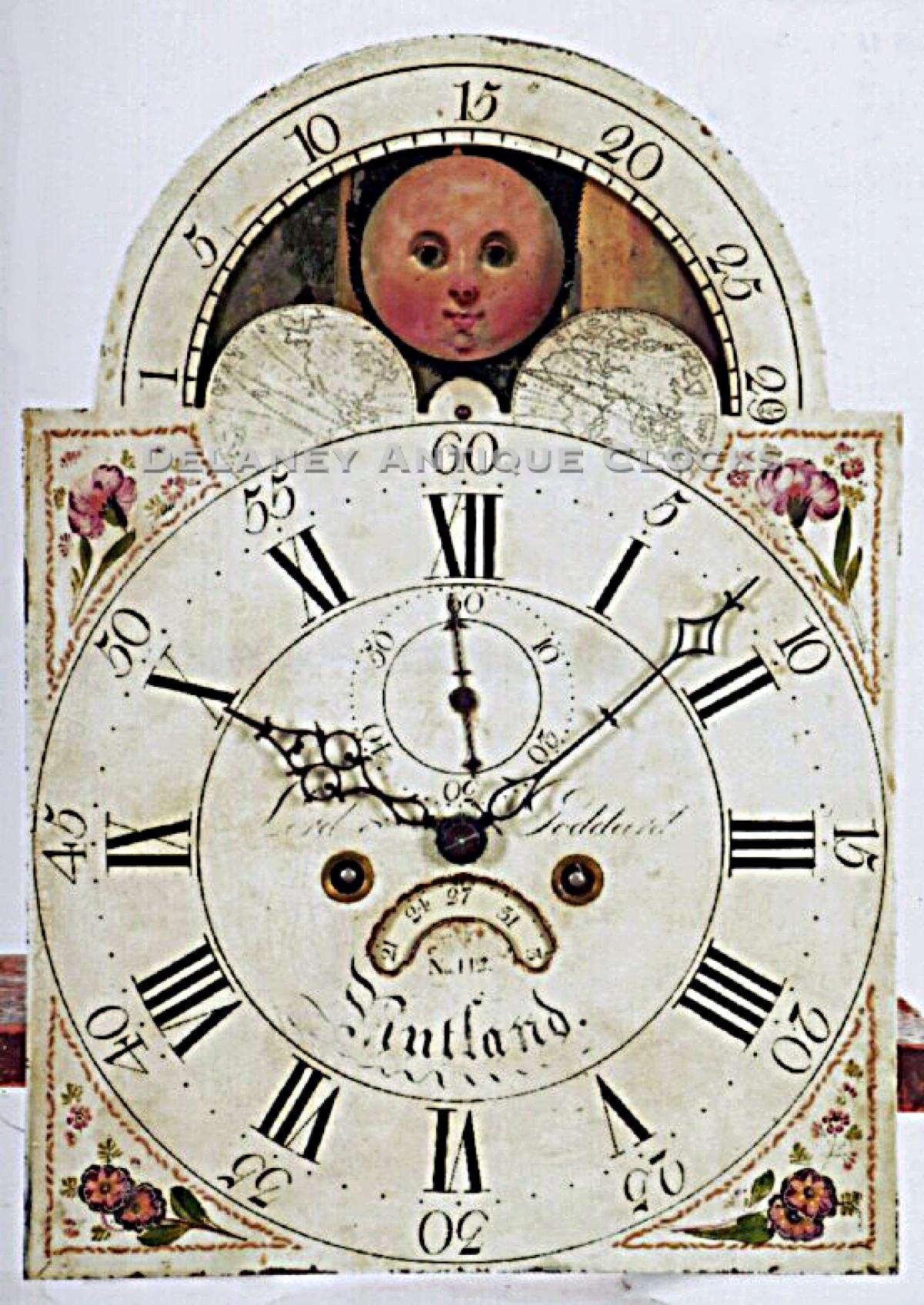Lord & Goddard Rutland, Vermont. No. 112. An inlaid cherry case tall clock. 216048.
This fine tall clock, housed in a cherry case with intricate inlay patterns, was made by the partnership of Lord & Goddard of Rutland, Vermont. The case, reminiscent of the high-style New York and New Jersey cases, is a striking feature. The use of cherry, decorative holly inlay patterns, and mahogany highlights further enhance its appeal.
This inlaid cherry case stands on French feet. Their original height has been slightly compromised. They are mounted to the base molding, which is applied to the bottom of the case. The base panel features two vertically positioned inlaid mahogany oval panels. These are framed with thin line inlays. The waist section is long. The center is fitted with a rectangular door. An applied molding gives the door some depth. In the center of this door is an additional inlaid oval. The mahogany veneer used in these ovals exhibits a good grain pattern. Fully turned and fluted quarter columns are inset into the corners of the waist. These are mounted in turned wooden capitals. A checkered rope or a barber pole inlay pattern trims the rest of this outside edge. This subtle detail is difficult to pick up in the photographs. The bonnet or hood features a swan’s neck pediment. The horns are delicately formed and terminate in inlaid pinwheels. One will find an additional oval inlaid in the front facade in the center. Three brass ball-and-spiked finials surmount this case. The two located at the corners are mounted on reeded plinths. Fluted bonnet columns flank the arched bonnet door. This door is also lined inlaid.
The painted dial is mounted to the movement with a false plate. The spandrel areas are decorated with fanciful gesso patterns that help highlight the colorfully painted floral themes. The clockmakers boldly sign this dial. The time track is formatted in the traditional Roman numerals, marking the hours, and Arabic numerals are used for each five-minute marker. A calendar and seconds bit are in the conventional locations. A moon phase mechanism or lunar calendar is located in the arch.
This fine movement is constructed in brass and is of good quality. Four-turned pillars support the two brass plates. Hardened steel shafts support the polished steel pinions and brass gearing. The winding drums are grooved. The escapement is designed as a recoil format. The weight-driven movement is designed to run for eight days on a full wind. It is a two-train or a time-and-strike design with a rack and snail striking system. As a result, it will strike each hour on the hour. This is done on a cast iron bell mounted above the movement. The hammer is returned to its ready position via a coil spring.
This clock was made circa 1806.
This clock stands approximately 92 inches tall.
A number of tall case clocks have been found signed by the Lord & Goddard partnership. Some of the following numbers recorded (up to 2016) include 72, 75, 87, 95, 97, 98, 111. 112 and 113.
The family that owned this clock provided the following information, which I have edited.
According to his granddaughter Flora B., in 1819, this clock was initially acquired by Eastus Barker. He was born in Tinmouth, VT, on May 23, 1766, and married Mabel Thompson of Wallingford, CT.
Stephen and Eliza Barrett operated a farm in Middletown Springs, VT. Stephen died in 1864, and Eliza and her son Fredric continued operating it until March 1873, when its contents were auctioned off. Eliza died in 1876. Son Fred B. Barrett married Mary Adams Warner (b. Pawlet, VT, January 5, 1857) in 1877, and they bought a mercantile in Middletown Springs from Mr. M.E. Vail. In 1885, they moved the business to a four-story brick building – known as the Joslin Block or Goodrich Hall, on Main Street, a block from the village’s Delaware & Hudson R.R. train station in Poultney, VT – where it was said to have been the largest dry goods/general store between the Albany/Troy, NY area and Burlington, VT.
The store held a dance hall, lumber barn, feed stall, ice house (with ice cut from Lake Saint Catherine by its own crews), a barber/beauty salon, on-site butcher, clothing, and millinery, in addition to being a general dry goods and food store. The store flourished, enabling Fred B. and Mary to acquire the big (21-room) “white house” on the hill at 3 Beaman Street in 1902. Fred B. and Mary (Warner) Barrett had one son, Fred Warner, born in 1883 in Middletown Springs. Fred W. graduated from Troy Conference Academy (pre-cursor to what is now Green Mountain College) in Poultney, working in the family store while not in school, then attended Syracuse University. He had just graduated from Syracuse University when both parents died in 1907, Mary on July 7 and Fredric on August 15. Fred W. took over ownership/management of the store and married Anna Clara DeYoe on August 26, 1908, after she graduated from Syracuse.
It appears that Erastus and Mabel Barker passed the clock on to their daughter, Eliza, and she directed it go to her daughter Flora, Fred B.’s sister. (Eliza was Stephen Barrett’s third wife; the prior two were deceased.) The first recorded mention of the clock in our family records was in Flora B. (Barker) Cook’s (Fred B.’s sister, see above) Last Will & Testament, probated in the town of Sandwich, County of DeKalb, in Illinois, upon her death on April 6, 1915. Flora (Barker) Cook’s will directed the distribution of her estate and said that she would be buried in the local Oak Ridge Cemetery, in the plot “owned by the R.C. Cook Estate.” She provided for various possessions to be given to “Willard B. Strong, Fred Barrett, and Clara Barrett.” The will’s Article Seven reads, “I give and bequeath to Fred Barrett my tall Eight Day Clock, that was grandfather Barker’s (i.e. Eastus’) in 1819, and one of my solid silver spoons marked “M.B.” (Mabel Barker) and E.B.” (Eastus Barker)”…and various other possessions…to Fred.
So it came back to the Barretts via Flora (Barker) Cook, who, with her second husband, Rollin C. Cook, wound up in Illinois and lived to age 69, presumably predeceased by Mr. Cook, her second husband.
So the clock returned to Vermont to my grandfather, Fred W. Barrett, in 1915. It occupied a spot in the front entryway of the “White House.” I remember my brother, our cousins, or me often ceremoniously winding it during every summer—we used to summer on Pine Point on Lake St. Catherine—or holiday visit in the late ‘40s/early ’50s. Then, #112 passed to his wife, my grandmother.
(I have omitted the tree of ownership from this point forward to protect the living family.)
An early 1900 photo of the clock shows it at the Holiday Open House Party. It is shown in the invitation in the entry foyer of the Barrett house at Three Beaman Street, Poultney, next to an antique Windsor chair, which the family still owns. The 21-room house was built in 1808 and is listed in the National Register of Historic Places. After long service as a residence and then Poultney’s Bank, the home spent more than a half-century with the Barrett family. Upon Fred W.’s death, it was sold to the town’s physician, Dr. Paul Swinyer, who lived in it and hosted his practice. It was later sold to a family that operated it as a bed and breakfast, The Stonebridge Inn. We have a photo of my family, aunts, uncles, and cousins on its front porch after a family reunion in the summer of 1988. In 1996, The home suffered severe fire damage. In time, the Town of Poultney restored it, and it now is the Poultney Community Center.
Inventory number 216048.
The partnership of Lord & Goddard was first advertised in the Rutland Herald on July 7, 1997. Their shop was located a few rods north of the Rutland Court House just opposite Messrs Pomeroy & Hooker’s store. At this location, they advertised the manufacture of musical clocks and most kinds of gold and silverware. In 1800, they moved approximately 15 rods northwest of the Court House into the shop formerly occupied by Storer & Wilmont. The Lord & Goddard’s partnership lasted approximately eight years and was dissolved on April 26, 1805. A notice was placed in the Rutland Herald on this date. They stayed close friends as their families remained involved in each other’s lives.
Benjamin Lord was born in Norwich, Connecticut, on October 10, 1770, the son of Ebenezer and Temperance (Edgerton). He was first listed as a silversmith in 1793 when he advertised in the Western Star in Pittsfield, Massachusetts, opposite the meeting house on the road to Lanesborough in 1796. Silver spoons are known with his stamp. It is recorded that in 1797, Benjamin moved into Rutland, Vermont, and was there before Goddard moved to town. He began working as a silversmith and watchmaker and, within a few short months, formed a partnership with the newly arrived Nichols Goddard. Benjamin married Fanny Buell in Coventry, Connecticut, on January 28, 1799. Together, they had at least six children while putting roots down in this Rutland. Benjamin became involved with public affairs and served as town clerk in 1803 - 1813 and again in 1815 - 1826. He was a Captain in the local militia. In 1808, he is thought to have trained his nephew John Bliss as a clockmaker. Bliss became a well-documented chronometer maker in New York. Benjamin died on April 23, 1843, in Athens, Georgia.
Nichols Goddard was born the son of Nathan and Martha (Nichols) Goddard in Shrewsbury, Massachusetts, on October 4, 1773. It is thought that he learned clockmaking from his second cousin, Luther Goddard, who was also in Shrewsbury. Luther was trained by his cousin, our country’s most famous clockmaker, Simon Willard of Grafton, in 1778. Luther is often credited with making the first watch in America. Nichols moved away and is listed as working in Northampton, Massachusetts, from 1794 through 1797. A diary entry from 1795 states that as a journeyman, Nichols made movements for his father Luther Goddard, Gardner Parker of Westborough, Isaac Gere of Northampton, Massachusetts, and for a man identified as “Ingalls,” who is also in Northampton. In June of 1797, Goddard moved north to Rutland, Vermont. At this time, the period of 1770 through about 1825, the state of Vermont enjoyed unprecedented population growth. In Rutland, Goddard formed a partnership with a silversmith who was originally from Norwich, Connecticut, and more recently Pittsfield, Massachusetts. His name was Benjamin Lord. In September of 1798, Nichols returned to Northampton to marry Charity White. She was the daughter of Job White (Clockmaker) and Charity Chapin. They returned to Rutland and had seven children together. When the Lord and Goddard partnership ended, Nichols continued making clocks under his name until he died in 1823.
Nichols also involved himself in public affairs. In 1800, he was appointed Town Clerk of Rutland. He also served as Town Treasurer from 1805 - 1807. He received the commission of Captain in the militia. He was also very active in the Masonic lodge. In 1802, he was elected Grand Junior Deacon of the Grand Masonic Lodge of Vermont, and from 1804 through 1810, he served as Grand Senior Warden.
Nichols died in Rutland on September 23, 1823.
The craftsmanship of Lord & Goddard's clocks, a testament to their skill and dedication, is a source of admiration. There are about a dozen clocks signed by Nichols Goddard or signed Lord & Goddard. A fine example signed Lord & Goddard No. 124, is located in the Sheldon Museum. A musical example, signed Nichols Goddard, is in the collection of The Bennington Museum. The Rutland Historical Society was given Nichols Goddard Number 150 in 1996. They also own number 106, which has a repainted dial. Each of these clocks, a unique blend of functionality and beauty, is a testament to the enduring legacy of Lord & Goddard's craftsmanship.
The tall case clocks signed by Lord & Goddard that have been found to date have the following numbers recorded: 72, 75, 87, 95, 97, 98, 106, 111, 112, and 113. Tall clocks signed by Nichols only include 118, 124, 125, 144, and 150.




